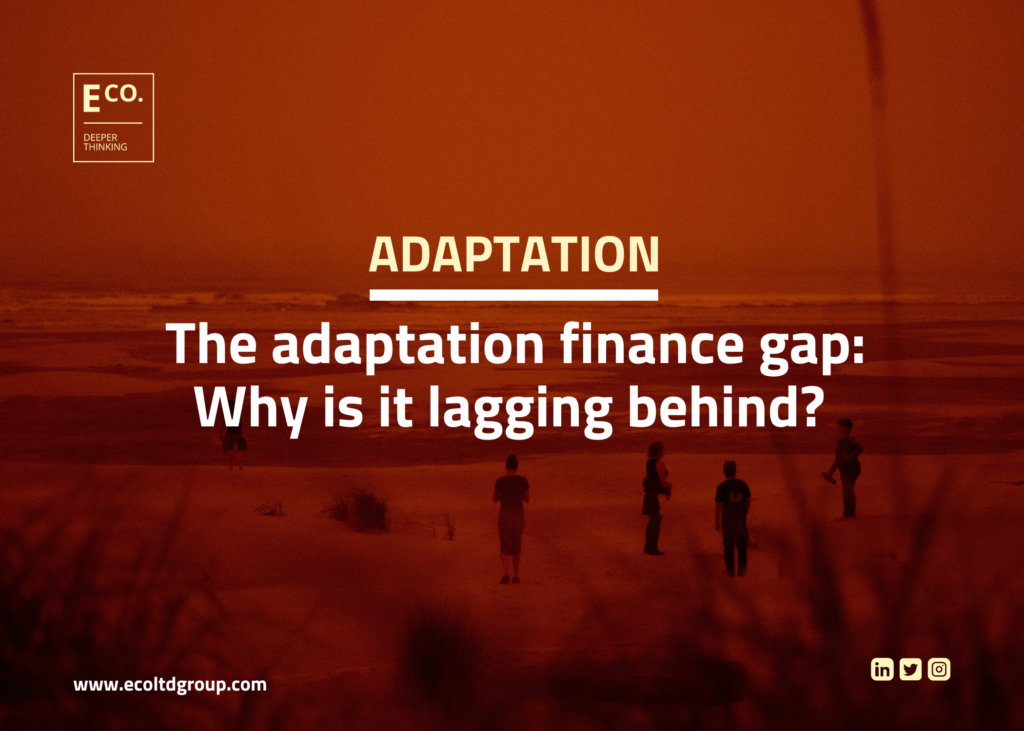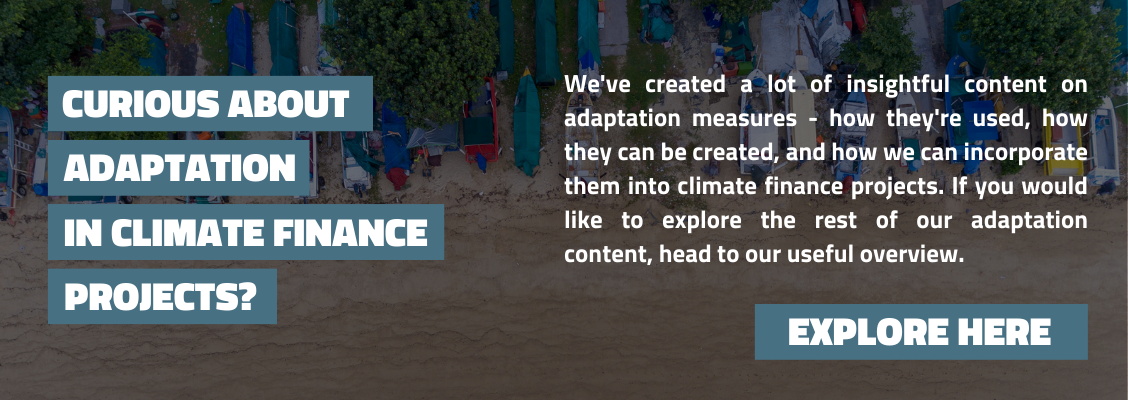The adaptation finance gap: Why is it lagging behind?
13 April 2023, Category: All insights, News, Tags: adaptation, adaptation gap, climate change, climate finance, COP27, project design, sustainable development

Let’s talk about the adaptation finance gap. In the world of climate change, attention seems to focus more on stopping future impacts. We regularly see climate models for 2050 or 2100 highlighting the enormous risks we face if we do not reduce emissions in line with the goals of the Paris Agreement.
Therefore, it is no surprise that the majority of resources, especially financial, currently aim to tackle mitigation. But we’re experiencing the devastating impacts of climate change now. From floods in Pakistan that affected over 33 million people and caused damages in excess of US $30 billion to record breaking wildfires throughout Europe and the worst drought in China in six decades, climate-related events regularly wreak untold havoc. So what is causing the adaptation finance gap?
To set the scene for the rest of the quarter, this first blog focuses on:
- The current state of adaptation finance;
- The gap compared to mitigation and why adaptation finance lags behind.
Subscribe to our newsletter
This blog is the first in our themed quarter that revolves around adaptation and adaptation finance. If you’d like to stay informed of all our blogs in a monthly round-up, sign up to our ‘Latest thinking’ newsletter.
Released once a month, this newsletter provides a glimpse into E Co’s climate finance world, including links to articles, insight from our experts, and other exciting news and updates you can access learnings from.
The adaptation finance gap
According to the World Resources Institute, adaptation finance is “finance for actions that help communities reduce the risks they face and harm they might suffer from climate hazards” such as storms or droughts.
At COP15 in Copenhagen, parties agreed upon the goal of mobilising US $100 billion in climate finance annually by 2020 from developed countries to developing countries. Research from the OECD, the organisation responsible for tracking climate finance flows, reveals a significant shortfall in the progress towards the goal – achieving US $83.2 billion in 2020. While adaptation finance has increased year on year, from US $16.9 billion in 2018 to US $20.3 billion in 2019 to US $28.6 billion in 2020, it still pales in comparison to the US $48.6 billion for mitigation.
The trends in global climate finance – total climate-related finance, including, but not limited to, government spending – echo a similar message. The Climate Policy Initiative (CPI) found that from the years 2011-2020, a cumulative US $4.8 trillion in climate finance was committed.
While rapid annual growth of around 7% is positive, the IMF states overall climate finance requires US $3-6 trillion annually by 2030 – with estimated annual adaptation needs between US $160 billion to $340 billion by the end of the decade, and up to $565 billion by 2050 – to avoid the worst impacts of climate change.
For 2020, the CPI tracked US $653 billion in global climate finance of which just 13.3% (US $49 billion) was for adaptation. Financing for energy-related mitigation measures shows the most progress whilst key adaptation sectors such as agriculture, forestry, and land use lag behind.
In the run-up to COP 27, the UN Environment Programme (UNEP) published their annual Adaptation Gap Report with a telling title – ‘Too little, Too slow’. They found that while adaptation planning continues at pace, with at least 84% of all countries party to the UNFCCC having plans (such as National Adaptation Plans (NAPs)), the finance required to implement them cannot keep up. In fact, they estimate the adaptation finance gap in developing countries is likely in the range of 5-10 times greater than currently available financial flows and is expected to widen, especially in a high-inflation macroeconomic environment. So, why is there such a big gap?
Why does adaptation finance lag behind?
One of the key challenges for accessing climate finance – both for adaptation and mitigation – is successfully making the argument from an investment perspective. The nature of the financial instruments used partly contributes to this challenge. Nearly 94% of existing climate finance is in the form of either debt or equity, where the funder expects a financial return, rather than grants which are not usually repayable. Typically, adaptation projects are more difficult to argue for on this basis. This is due to several reasons:
- Critical adaptation measures may not actually lead to revenue generation. Interventions such as building flood defences and seawalls indirectly provide economic co-benefits through protection but do not generate revenue. Instead, in this case, economic and/or financial benefits are in the form of avoided losses rather than new, additional revenue.
- The economic benefits of adaptation interventions, such as return on investment, may be difficult to accurately quantify and calculate compared to mitigation. For example, if a mitigation project focuses on building renewable energy capacity and selling the energy generated by the newly-installed infrastructure, it is relatively simple to determine the revenue-generating potential – multiply the use of power (kWh) by the cost per kWh. Even with fluctuating costs, it is easy to at least determine a likely range for revenue. For adaptation, building on our previous example, building flood defences may stop contaminated water from infecting the local population and yield health benefits, or prevent the loss of crop harvests and yield food security benefits but being able to assign an accurate dollar value to this is much harder.
- The lack of a universally agreed adaptation indicator can make it difficult to accurately assess impacts, which can put off investors. Most of the major donors, such as the GCF, discuss adaptation impact in terms of the number of people benefitting from increased resilience to climate change impacts but this remains relatively ambiguous. Enhanced resilience for fishermen in the Caribbean will look totally different to enhanced resilience for smallholder farmers in India or sub-Saharan Africa. Each investment will require context-specific sub-indicators to assess impact, which adds an additional layer of complexity. Whereas, for mitigation, regardless of the sector or geography, the indicator is the tonnes of CO2 emissions reduced or avoided resulting from interventions.
- Finally, linking funding to revenue generation creates additional pressures. Many of the countries most vulnerable to climate change – those in need of adaptation finance the most – already do not have ‘investment grade’ opportunities, may suffer from high national debt, and/or do not have markets currently developed enough to attract international investors at the necessary scale. Combining this with a very challenging macroeconomic environment will likely put off risk-averse investors.
Closing the adaptation finance gap is critical for the most vulnerable people but also presents opportunities. Research by the Global Center on Adaptation (GCA) found that every US $1 invested in climate adaptation could yield between US $2 and $10 in net economic benefit, showing the enormous potential societal positives stemming from proactively tackling climate change.
Looking forward in our adaptation quarter
Throughout our second themed quarter of 2023 we will discuss adaptation and the many sub-topics related to it. This includes:
- Adaptation finance and the gap compared to mitigation;
- Indigenous groups and their importance in tackling climate change;
- Nature-based solutions and their role in adaptation;
- Challenges and opportunities for loss and damage financing.
You can explore all of this content via the link below.
In our next blog, we’ll be talking about Loss and Damage. For many years, discussions surrounding funding for loss and damage were thrown under the umbrella of adaptation finance. While similarities certainly exist between both topics, keeping loss and damage in the shadow of adaptation finance threatened to downplay the importance of both as separate, but linked, issues whilst also potentially short-changing the funding available for both.
Now, after three decades of campaigning for a standalone Loss and Damage Fund, it was finally agreed at COP27. Our next blog will explore how this new funding mechanism could work, the process faced to build it, and the challenges and opportunities that come with it.
Looking to develop innovation within a climate finance project or programme?
Get in touch with our climate finance consultants to discuss a project you’re working on and create successful, fit-for-purpose projects, now and in the future. Email us at: amy@ecoltdgroup.com or find us at the following:
Twitter: @ecoltdnews
LinkedIn: E Co.
Instagram: @ecoltdnews
One Reply
Join the conversation by posting a comment below. You can either use your social account, by clicking on the corresponding icons or simply fill in the form below. All comments are moderated.

[…] than the general barriers to financing adaptation actions, urban adaptation has its own set of […]